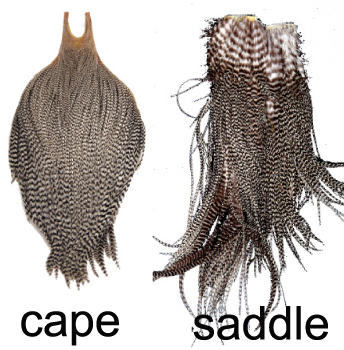Guidelines for Choosing Genetic Hackle!
Your source for flyfishing and flycraft resources since 1975.
This is one of the great sources of discussion among fly tyers and also a source of great confusion for new folks. But just let me say that the guidelines presented here will be simple in order that a 'newbie' or 'novice' will feel competant to purchase the hackle she needs.
Dry Fly Hackle
 When talking about 'genetic hackle,' most tyers think of dry fly rooster materials. Behold the rooster in all its magnificance! (photo at left). This beautiful animal is bred primarily for its feathers which are used in fly tying. And for the record, the most think, and I agree, that the quality of genetic hackle available today far exceeds that which was available only 25 years ago.
When talking about 'genetic hackle,' most tyers think of dry fly rooster materials. Behold the rooster in all its magnificance! (photo at left). This beautiful animal is bred primarily for its feathers which are used in fly tying. And for the record, the most think, and I agree, that the quality of genetic hackle available today far exceeds that which was available only 25 years ago.
So we'll start this discussion talking about rooster material which is used for dry flies. As you can see from the photo, there are two distinct ares of the chicken that supply dry fly hackles. The cape is the part behind the neck, just like Superman or Batman wears his cape. The saddle is like the saddle on a horse. They're the parts that hang to either side as if you were sitting on the bird. For the record, I do not recommend sitting on a live rooster!
First, some notes on Capes vs. Saddle feathers. Years ago, capes were for dry fly tying and saddles for wet material. But since the last 20 years or so, some saddles have become the finest dry fly material available. From the photograph of my chicken (above), you can see that the cape comes from the back of the neck, and the saddle feathers drape over the sides. Take a closer look below:
 Comparing the two parts, notice that the cape (left) has shorter feathers, but a wide variety of sizes. This means you’ll be able to tie flies from a size 6 up to a size 24! So if you are planning to tie flies in a broad range of sizes, you’ll probably be interested in purchasing mainly capes.
Comparing the two parts, notice that the cape (left) has shorter feathers, but a wide variety of sizes. This means you’ll be able to tie flies from a size 6 up to a size 24! So if you are planning to tie flies in a broad range of sizes, you’ll probably be interested in purchasing mainly capes.
On the other hand, saddles have a small range of feather sizes so you might obtain a saddle that has feathers predominantly in the 12, 14 & 16 sizes only, which is great if you do most of your tying in these sizes (I should note that there are saddles that have smaller ranges, maybe 16, 18 & 20’s. Similarly, the range can be among larger sizes as well. Personally, I like saddles better for several reasons: first, since I do most of my tying in a small range, it’s more economical to pick out a saddle that will satisfy my need for a long time making it a more economical choice and second, their long stems make them easy to wind around a hook without the need for hackle pliers, which can be a nuisance. I like the idea that I can usually get 4-5 dry flies out of one saddle feather.
Ah, you say, but what about the ratings? Are your Premium better than your Choice, is #1 better than #2 and is Gold better than Silver or Bronze? Well, the right answer is . . . maybe! I've met folks that assign the above ratings to capes and saddles, met with growers of genetic hackle and have spoken with scores of professional fly tyers. The bottom line is that our Choice line of feathers, a Bronze Whiting or a #2 Metz will tie beautifully for about 95% of the folks that tie. It's that simple. As I said above, the quality is so much higher than 25 years ago, that virtually all of the grades are better quality than in the past.
Frank D'Angelo, a professional fly tyer from central Pennsylvania and good friend, likes to say "pretty flies catch fishermen" and "all fly catch fish!" In other words, very minute differences will usually matter only to the tyer, not the fish. Don't stress out on this issue or you won't enjoy tying.
'Non' Dry Fly Genetic Hackle
You'll find a huge array of genetic hackle used for streamer, wets, saltwater, spey, tails and so on. These are sometimes dyed bright colors, grizzly, solid and larger. These may be from a rooster or a hen. If you intend to tie flies that require this, the pattern recipe will let you know. These are usually less expensive than the high quality dry fly rooster material mentioned at the beginning of this article.
Buy H&H "Premium" Hackle
Buy H&H "Choice" Hackle
Buy H&H "Quality" Hackle
Buy Whiting Hackle
Buy Metz Hackle
Buy Ewing Hackle






